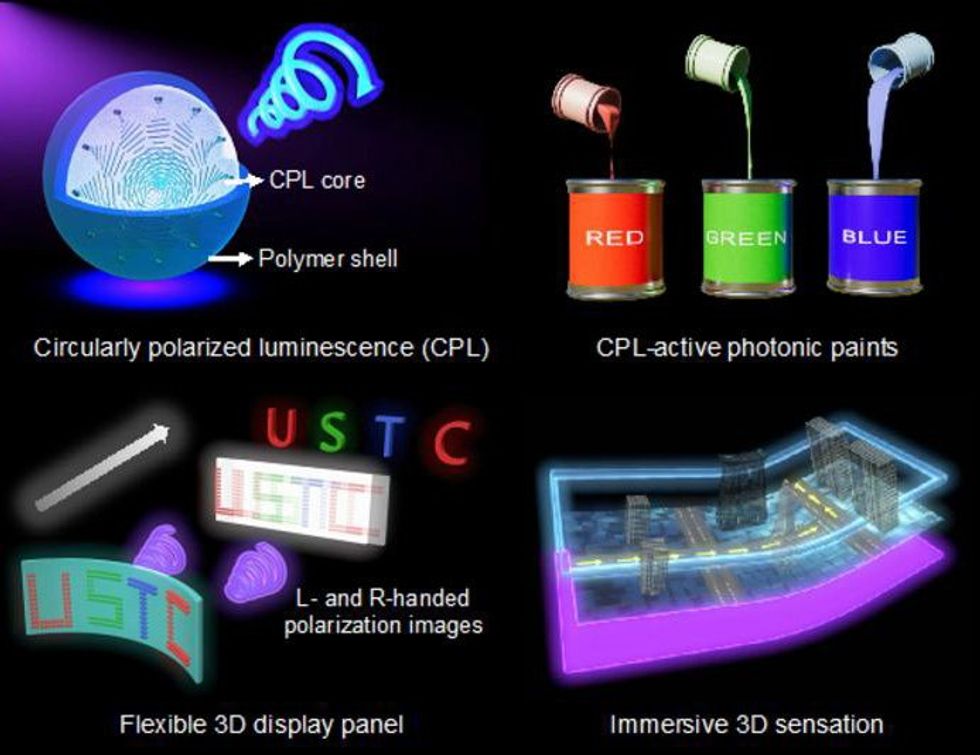Flexible 3D displays may be possible using novel paints that manipulate the way in which light can spiral through space, a new Chinese study finds.
Our ability to see in 3D is an illusion. In actuality, our eyes see two slightly different views of the world, because of the small distance separating them. The brain then combines those images into a 3D view of the world.
To mimic that illusion, 3D displays show a different image to each eye, typically using linearly polarized glasses. The display will polarize some of the light in one direction, and the rest of the light—showing a slightly different image—at a perpendicular angle. By wearing a pair of linearly polarized glasses, a viewer sees only one image with each eye, creating a similar 3D illusion.
However, when someone tilts their head while wearing linearly polarized glasses, the result can lead to the polarized images leaking into the opposite lens. This means viewers have to keep their heads level to maintain the 3D effect, which makes prolonged viewing uncomfortable.

Another strategy for 3D displays involves the way in which light beams can spiral much like threads on a screw, either with right-handed circular polarization (meaning they rotate clockwise) or left-handed circular polarization (counterclockwise). Tilting one’s head is less of a problem when wearing circularly polarized glasses.
In principle, dyes that can emit circularly polarized light can be printed onto flexible panels to create foldable, stretchable 3D displays. In practice, it has proven challenging to develop printable substances that can emit light that is mostly circularly polarized.
In a new study, researchers at the University of Science and Technology of China and Anhui University, both in Hefei, China, experimented with chiral liquid crystals. Previous research found that when these materials are coupled with light emitters, they can generate strongly circularly polarized light.
Although chiral liquid crystals are widely used in display and imaging technologies, previous applications were limited to chiral liquid crystals that were relatively fluid in how their molecules were arranged. In order for these crystals to prove useful, they need to be confined between layers or in cells that can control how these molecules are structured, an arrangement that prevents their use in flexible displays.
In the new study, the researchers coupled chiral liquid crystals with fluorescent dyes that emitted red, green, or blue light. The scientists developed a way to encapsulate this mixture in a polymer shell to control the structure of the chiral liquid crystals. The resulting paints could emit intensely circularly polarized colored light.
The researchers used their new paints to create paired groups of pixel arrays in flexible color 3D images printed on materials such as cotton, polyester, and plastic. These included a picture of a bridge about the size of a sheet of printer paper, and a watchlike panel worn on a wristband.
Potential applications for the new flexible 3D displays include “wearable electronics, such as smartwatches, fitness trackers, and augmented reality glasses, to provide high-resolution 3D visual information in a compact and flexible form factor,” says study co–senior author Taotao Zhuang, a chemist at the University of Science and Technology of China. They can also “be integrated into curved surfaces, such as automotive dashboards or aircraft interiors, to create immersive 3D visual interfaces.”
The scientists detailed their findings 25 October in the journal Science Advances.
Charles Q. Choi is a science reporter who contributes regularly to IEEE Spectrum. He has written for Scientific American, The New York Times, Wired, and Science, among others.



